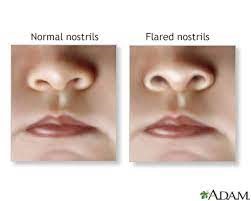A nurse is assessing a newborn following a vaginal delivery. Which of the following findings should the nurse report to the provider?
Heart rate 136/min
Nasal flaring
Transient strabismus
Overlapping of sutures
The Correct Answer is B
A. Heart rate 136/min is a normal finding for a newborn. The normal range of heart rate for a newborn is 100 to 160/min.
B. Nasal flaring is an abnormal finding for a newborn. Nasal flaring indicates respiratory distress and may be caused by conditions such as pneumonia, meconium aspiration, or congenital heart defects.
C. Transient strabismus is a normal finding for a newborn. Transient strabismus is a temporary misalignment of the eyes that occurs due to weak eye muscles and poor coordination. It usually resolves by 3 to 6 months of age.
D. Overlapping of sutures is a normal finding for a newborn. Overlapping of sutures is caused by molding of the skull during delivery and allows the head to fit through the birth canal. It usually resolves within a few days after birth.

Nursing Test Bank
Naxlex Comprehensive Predictor Exams
Related Questions
Correct Answer is {"A":{"answers":"B"},"B":{"answers":"A"},"C":{"answers":"A"},"D":{"answers":"B"}}
Explanation
Correct Answer is ["B","C","E","F"]
Explanation
A. Blood pressure: A normal blood pressure for an adolescent is 110/70 mm Hg. The question does not provide the adolescent's blood pressure, so it cannot be determined if it requires follow-up or not.
B. Capillary refill: A normal capillary refill time is less than 2 seconds. A prolonged capillary refill time indicates impaired blood flow to the extremity, which could be due to vascular injury, compartment syndrome, or shock.
C. Pedal pulse: A normal pedal pulse is +2 or +3. A weak pedal pulse (+1) indicates reduced blood flow to the extremity, which could be due to vascular injury, compartment syndrome, or shock.
D. Heart rate: A normal heart rate for an adolescent is 60 to 100 beats per minute. The question does not provide the adolescent's heart rate, so it cannot be determined if it requires follow-up or not.
E. Skin temperature: A normal skin temperature is warm and dry. A cool skin temperature indicates reduced blood flow to the extremity, which could be due to vascular injury, compartment syndrome, or shock.
F. Pain: A pain level of 10 on a scale of 0 to 10 indicates severe pain that needs to be managed with appropriate analgesics and nonpharmacological interventions.
Whether you are a student looking to ace your exams or a practicing nurse seeking to enhance your expertise , our nursing education contents will empower you with the confidence and competence to make a difference in the lives of patients and become a respected leader in the healthcare field.
Visit Naxlex, invest in your future and unlock endless possibilities with our unparalleled nursing education contents today
Report Wrong Answer on the Current Question
Do you disagree with the answer? If yes, what is your expected answer? Explain.
Kindly be descriptive with the issue you are facing.
